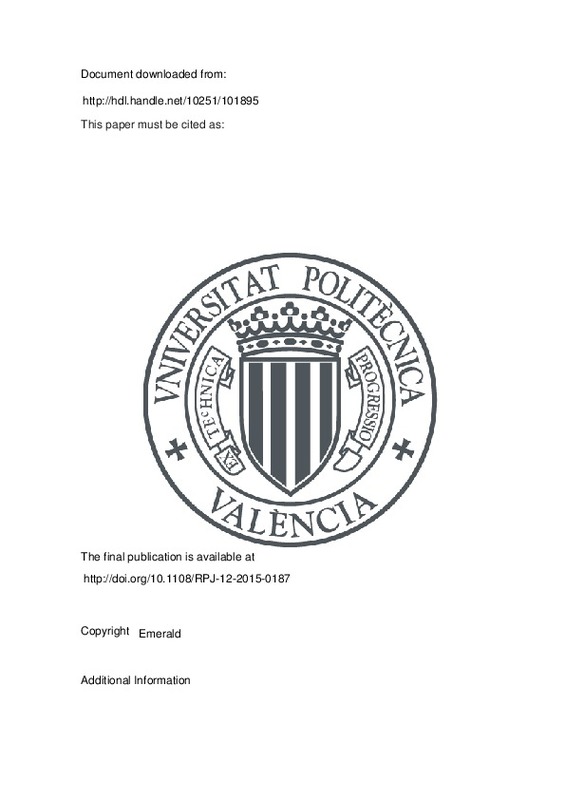JavaScript is disabled for your browser. Some features of this site may not work without it.
Buscar en RiuNet
Listar
Mi cuenta
Estadísticas
Ayuda RiuNet
Admin. UPV
Low cost digital fabrication approach for thumb orthoses
Mostrar el registro sencillo del ítem
Ficheros en el ítem
| dc.contributor.author | Fernandez-Vicente, Miguel
|
es_ES |
| dc.contributor.author | Escario Chust, Ana
|
es_ES |
| dc.contributor.author | Conejero Rodilla, Andrés
|
es_ES |
| dc.date.accessioned | 2018-05-14T04:20:04Z | |
| dc.date.available | 2018-05-14T04:20:04Z | |
| dc.date.issued | 2017 | es_ES |
| dc.identifier.issn | 1355-2546 | es_ES |
| dc.identifier.uri | http://hdl.handle.net/10251/101895 | |
| dc.description.abstract | [EN] Purpose - The purpose of this paper is to describe a novel design workflow for the digital fabrication of custom- made orthoses (CMIO). It is intended to provide an easier process for clinical practitioners and orthotic technicians alike. It further functions to reduce the dependency of the operators' abilities and skills. Design/methodology/approach - The technical assessment covers low-cost three-dimensional (3D) scanning, free computer-aided design (CAD) software, and desktop 3D printing and acetone vapour finishing. To analyse its viability, a cost comparison was carried out between the proposed workflow and the traditional CMIO manufacture method. Findings - The results show that the proposed workflow is a technically feasible and cost-effective solution to improve upon the traditional process of design and manufacture of custom- made static trapeziometacarpal (TMC) orthoses. Further studies are needed for ensuring a clinically feasible approach and for estimating the efficacy of the method for the recovery process in patients. Social implications - The feasibility of the process increases the impact of the study, as the great accessibility to this type of 3D printers makes the digital fabrication method easier to be adopted by operators. Originality/value - Although some research has been conducted on digital fabrication of CMIO, few studies have investigated the use of desktop 3D printing in any systematic way. This study provides a first step in the exploration of a new design workflow using low-cost digital fabrication tools combined with non-manual finishing. | es_ES |
| dc.language | Inglés | es_ES |
| dc.publisher | Emerald | es_ES |
| dc.relation.ispartof | Rapid Prototyping Journal | es_ES |
| dc.rights | Reserva de todos los derechos | es_ES |
| dc.subject | Surface treatment | es_ES |
| dc.subject | Lattice structures | es_ES |
| dc.subject | 3D scanning | es_ES |
| dc.subject | Costs analysis | es_ES |
| dc.subject | FFF | es_ES |
| dc.subject | Meshmixer | es_ES |
| dc.subject.classification | DIBUJO | es_ES |
| dc.title | Low cost digital fabrication approach for thumb orthoses | es_ES |
| dc.type | Artículo | es_ES |
| dc.identifier.doi | 10.1108/RPJ-12-2015-0187 | es_ES |
| dc.rights.accessRights | Abierto | es_ES |
| dc.contributor.affiliation | Universitat Politècnica de València. Departamento de Dibujo - Departament de Dibuix | es_ES |
| dc.contributor.affiliation | Universitat Politècnica de València. Instituto de Diseño para la Fabricación y Producción Automatizada - Institut de Disseny per a la Fabricació i Producció Automatitzada | es_ES |
| dc.description.bibliographicCitation | Fernandez-Vicente, M.; Escario Chust, A.; Conejero Rodilla, A. (2017). Low cost digital fabrication approach for thumb orthoses. Rapid Prototyping Journal. 23(6):1020-1031. doi:10.1108/RPJ-12-2015-0187 | es_ES |
| dc.description.accrualMethod | S | es_ES |
| dc.relation.publisherversion | http://doi.org/10.1108/RPJ-12-2015-0187 | es_ES |
| dc.description.upvformatpinicio | 1020 | es_ES |
| dc.description.upvformatpfin | 1031 | es_ES |
| dc.type.version | info:eu-repo/semantics/publishedVersion | es_ES |
| dc.description.volume | 23 | es_ES |
| dc.description.issue | 6 | es_ES |
| dc.relation.pasarela | S\350175 | es_ES |







![[Cerrado]](/themes/UPV/images/candado.png)

